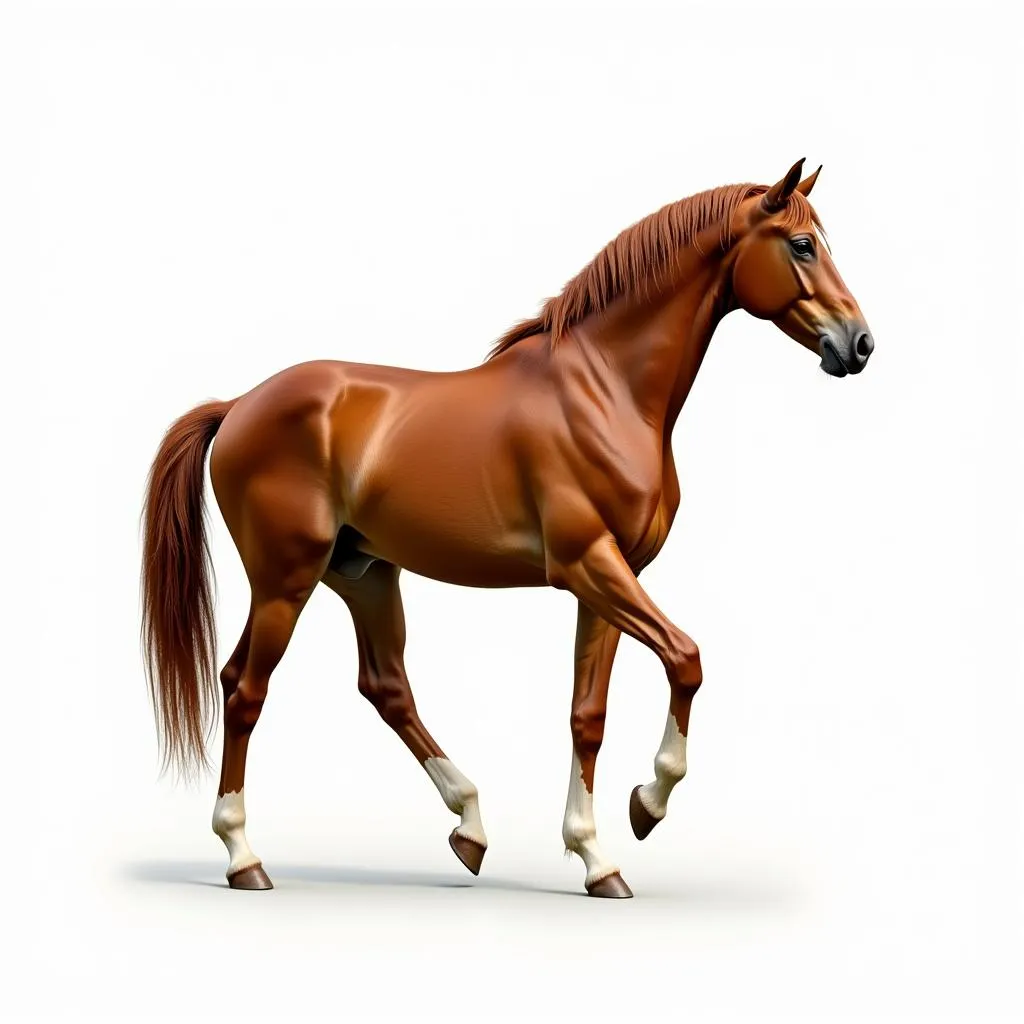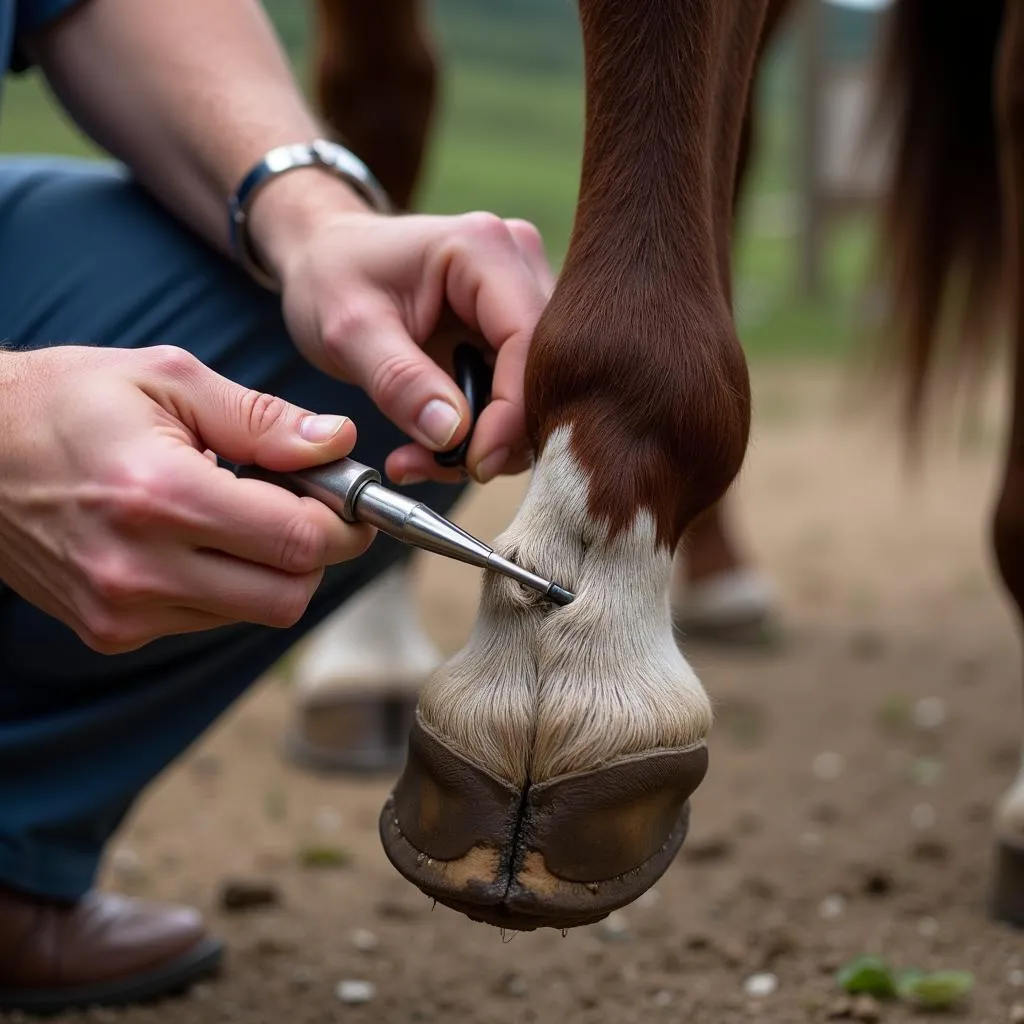When a horse starts walking on its toe, especially in the hind leg, it’s a major red flag signaling something is wrong. This abnormal gait, where the horse avoids putting full weight on its heel, can stem from various factors, ranging from mild inflammation to serious conditions. This article delves into the possible causes, diagnosis, and treatment options for this potentially debilitating issue.
 Horse Walking Abnormally on its Toe
Horse Walking Abnormally on its Toe
Common Causes of Toe-Touching in Horses
1. Navicular Syndrome: This often-inherited condition affects the navicular bone and surrounding structures in the hoof. Inflammation and degeneration within the hoof capsule cause pain and force the horse to shift its weight forward, leading to toe-first landing.
2. Laminitis: This painful inflammatory condition affects the laminae, which attach the pedal bone to the hoof wall. Acute or chronic laminitis makes weight-bearing excruciating, prompting the horse to walk on its toes to minimize pressure on the heels.
3. Abscesses: An infection within the hoof can form a painful abscess. To avoid pressure on the affected area, the horse alters its gait, often resulting in toe-walking, especially if the abscess is located in the heel region.
4. Injuries: Bruises, punctures, or fractures in the hoof, pastern, or coffin bone can cause significant pain. To protect the injured area, the horse might adopt a toe-walking gait as a protective mechanism.
5. Tendon and Ligament Issues: Inflammation or damage to tendons and ligaments, such as the deep digital flexor tendon, can alter the horse’s stride and lead to toe-touching.
6. Neurological Problems: While less common, neurological conditions affecting the horse’s nerves and spinal cord can disrupt normal gait and lead to abnormal weight distribution, including toe-walking.
Recognizing the Signs
Early detection is crucial for effective treatment. Apart from the obvious toe-first landing, other signs include:
- Shortened strides: The horse takes shorter, choppier steps, particularly noticeable in the hind legs.
- Reluctance to move: The horse might be hesitant to move, especially on hard or uneven surfaces.
- Increased heat in the hoof: The affected hoof might feel warmer to the touch compared to other hooves.
- Lameness: The degree of lameness can vary from subtle to severe, depending on the underlying cause and its severity.
 Veterinarian Examining Horse's Hoof
Veterinarian Examining Horse's Hoof
Diagnosis and Treatment
If you suspect your horse is walking on its toe, immediate veterinary attention is vital. The veterinarian will conduct a thorough examination, including:
- Physical exam: Observing the horse’s posture, gait, and palpating the legs and hooves for any abnormalities.
- Hoof testers: Applying pressure to specific areas of the hoof to pinpoint the source of pain.
- Nerve blocks: Injecting local anesthetic to numb specific nerves and determine the location of the problem.
- X-rays: Taking images of the hoof and surrounding structures to identify fractures, bone changes, or other issues.
- Ultrasound: Using sound waves to visualize soft tissues like tendons and ligaments for signs of damage.
Treatment depends entirely on the underlying cause and might involve:
- Rest and restricted activity: Allowing the affected structures time to heal.
- Corrective shoeing: Applying therapeutic shoes or pads to support the hoof and alleviate pressure.
- Medications: Administering pain relievers, anti-inflammatories, or antibiotics as needed.
- Surgery: In some cases, surgical intervention might be necessary to address specific issues like bone fragments or tendon injuries.
Preventing Toe-Walking in Horses
While not all causes are preventable, certain practices can significantly reduce the risk:
- Regular hoof care: Schedule trims every 6-8 weeks with a qualified farrier to maintain proper hoof balance and angle.
- Appropriate exercise: Avoid overworking your horse, especially on hard surfaces, and provide adequate warm-up and cool-down periods.
- Balanced diet: Ensure your horse receives a balanced diet with all the necessary nutrients to support hoof health.
- Early detection and treatment: Address any signs of lameness or hoof problems promptly to prevent minor issues from escalating.
Conclusion
A horse walking on its toe, particularly in the hind leg, is a serious concern that demands immediate attention. Recognizing the signs and seeking prompt veterinary care is crucial for a positive outcome. Remember, early diagnosis and appropriate treatment offer the best chance for a full recovery and a return to comfortable, sound movement for your equine companion.
FAQs
1. Can a horse recover fully from walking on its toe?
Recovery depends on the underlying cause and the severity of the condition. With prompt treatment and proper management, many horses can recover fully or regain significant function.
2. Is toe-walking more common in certain breeds?
While any breed can be affected, some breeds, like Thoroughbreds and Quarter Horses, might be predisposed to conditions like navicular syndrome, which can lead to toe-walking.
3. What should I do if I notice my horse is suddenly walking on its toe?
Immediately confine your horse to a stall or small paddock to restrict movement and contact your veterinarian as soon as possible for an examination.
Still Have Questions?
If you’re concerned about your horse’s gait or have further questions, please don’t hesitate to contact us. Our team at Justus Horses USA is dedicated to providing expert advice and support for all your equine needs.
Contact Us:
Phone: 0772127271
Email: [email protected]
Address: QGM2+WX2, Vị Trung, Vị Thuỷ, Hậu Giang, Việt Nam
We’re here to help you and your equine partner live a healthier, happier life!